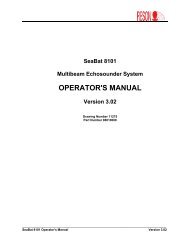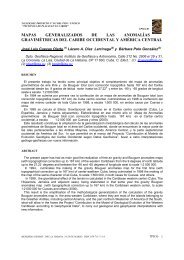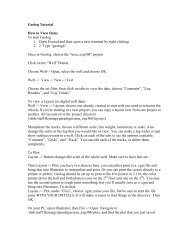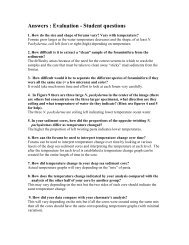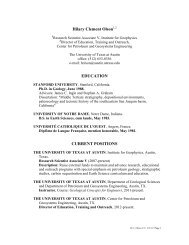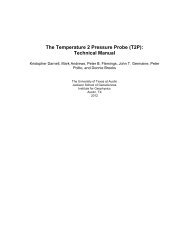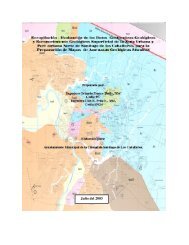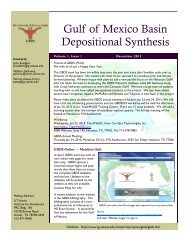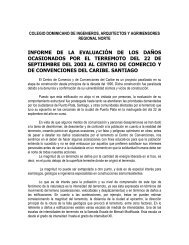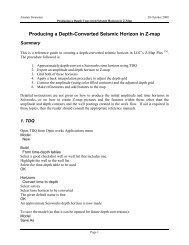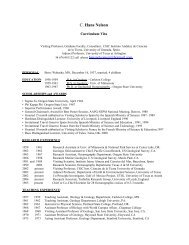IGCP Project short title: Caribbean Plate Tectonics Duration and ...
IGCP Project short title: Caribbean Plate Tectonics Duration and ...
IGCP Project short title: Caribbean Plate Tectonics Duration and ...
You also want an ePaper? Increase the reach of your titles
YUMPU automatically turns print PDFs into web optimized ePapers that Google loves.
4. Change in geochemical character from PIA to CA in many circum-<strong>Caribbean</strong> arcs.<br />
22<br />
5. The earlier the flip occurred, the easier would occur tectonically. At 120 Ma, the arc<br />
would have been <strong>short</strong> <strong>and</strong> straight <strong>and</strong> there was a powerful potential mechanism available<br />
(the acceleration of the opening of the Atlantic. At 75 Ma, the arc was ~2000km in length,<br />
<strong>and</strong> may have been very highly arcuate in shape, which would require huge internal<br />
deformation as the convex side changes from the SW to the SE.<br />
However, in the discussion it was conceded that there is growing evidence for an<br />
earlier (<strong>and</strong> possibly more voluminous (Diebold et al., 1999)) pulse of plateau magmatism<br />
around 130-120 Ma. If that is the case, an earlier plateau could have formed <strong>and</strong> caused the<br />
postulated subduction flip, <strong>and</strong> the later plateau building events (78, 90) could have<br />
represented the last pulses of magmatism.<br />
Pindell's suggestion (pers. com.) was for plateau workers to suggest possible<br />
mechanisms for plateau emplacement within the 2500 km wide proto-<strong>Caribbean</strong> plate<br />
following the flip, with perhaps only the first ~300 km of the leading edge of the plate<br />
overlying the Benioff zone, hence allowing the Aruba batholith etc to be formed at 85-82<br />
Ma. from subduction of normal oceanic crust beneath the plateau.<br />
Second day's discussion focussed on the following areas:<br />
1. The possible older 120Ma. pulse of plume magmatism. There appears to be growing<br />
evidence for it around the Carribbean (eg Lapierre, 2001; Diebold et al., 1999)<br />
2. Whether the plateau was derived from the Galapagos plume. New palinispastic<br />
reconstructions say it's impossible (Pindell, 2001). Trace element <strong>and</strong> isotopic geochemistry,<br />
however, do not rule it out (Hauff et al., 2000)<br />
3. The cause of the spread to high 87 Sr/ 86 Sr for the plateau lavas. Revillion (1999)<br />
analysed clinopyroxene separates from the Gorgona komatiites for Sr <strong>and</strong> concluded that it<br />
was primary as it correlates with the trace element abundances. This is supported by Kerr et<br />
al. (1996) who found that the high Sr composition of samples from the Curacao plateau<br />
sequence stayed constant with increased leaching <strong>and</strong> therefore attributed it to the<br />
incorporation of altered basalt into the source of the basalts. However, Thompson et al<br />
(2001) found that for the Upper Cretaceous arc lavas, which had initial 87 Sr/ 86 Sr of 0.7065,<br />
fresh apatite separates had much lower 87 Sr/ 86 Sr than the whole rock, <strong>and</strong> concluded that this<br />
spread to high 87 Sr/ 86 Sr was the result of alteration of the whole rock.<br />
4. How Gorgona relates to the rest of the plateau. The Gorgona komatiites have a<br />
depleted eHf-eNd isotopic composition (Thompson et al. 2001), which is distinct from the<br />
rest of the <strong>Caribbean</strong> plateau. This suggests that they are sampling an additional depleted<br />
component. But we don't know the exact nature of their relationship to the rest of the<br />
plateau.<br />
22



